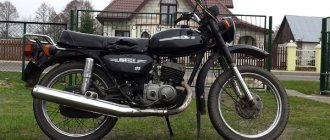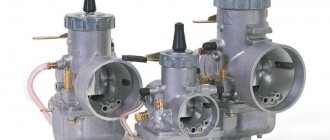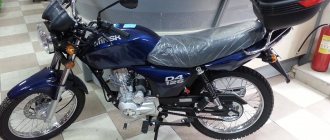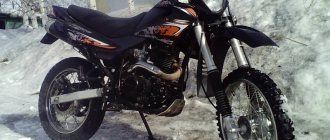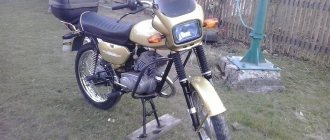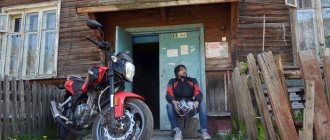Motorcycle Minsk D4 125 characteristics review
Minsk D4 125 produced at the Minsk-Moto plant. The model has a single-cylinder four-stroke carburetor engine with a power of 10.5 liters. strength The gearbox has five gears. The fuel tank has a capacity of 12 liters and is filled with fuel not lower than A-92. The engine starts using an electric starter, but there is also a kickstarter. The seat is covered with a special material protecting the motorcyclist from sliding off the seat. One thing to note about the brakes is that the front brake is hydraulic (disc) and is operated by hand. The rear block type is operated by the foot.
The ground clearance of the motorcycle is 210 mm. The front fork is telescopic. The rear suspension is pendulum with two shock absorbers. The front and rear wheels are the same size 3.00 by 18. The dry weight of the motorcycle is 100 kg. Maximum speed 100 km per hour.
The instrument panel and control switches are visible in the photo. In general, the motorcycle is not bad, cheap, affordable.
Return to contents — ↑
What was good about Minsk
If we consider the legendary “Minsk-125” further, we can note the following obvious advantages, which often outweighed the disadvantages and pushed motorcyclists to buy a bike:
Light weight . As mentioned above, the bike weighs only 120 kg, which allowed even not very large motorcyclists to move it however and wherever they wanted.
Acceptable dynamics . Today, a maximum speed of 95 km/h will not surprise anyone, but at that time such a performance indicator was considered outstanding. “Minsk” quickly picks up speed and is easy to climb, allowing true motorcycle enthusiasts to enjoy the speed.
Simple design . A motorcycle can be repaired in a garage without any problems; all you need is a set of tools, free time and a desire to repair the equipment.
Inexpensive and accessible spare parts . “Minsk” was distinguished by simple and affordable maintenance; spare parts were not difficult to find and purchase. Even after several decades, the spare parts needed to repair the bike can be found, and for pennies.
Of course, today “Minsk-125” is a bygone era, modern copies produced by the plant no longer have anything in common with the old copies. However, if you walk through the garages of motorcycle enthusiasts today, you will find thousands of Soviet motorcycles, some of them gathering dust, others in use.
The high popularity of the equipment is evidenced by the numbers - deliveries to 45 countries of the world; in total, over 6.5 million copies of the motorcycle were produced. From the first years, “Minsk” began to take part in cross-country and circuit racing. The first cross and enduro M-201M were created in 1956. In the 90s, the motorcycle became a favorite among young motorcyclists. First of all, for ease of control . It is much simpler and easier to operate than the Ural, IZH or Voskhod. Plus, I had to refuel much less often, since fuel consumption per hundred is scanty. There were some shortcomings, for example, not the most reliable engine, but often this factor was not paid attention to.
Minsk M-103.
Minsk M-104.
Minsk M-105.
Minsk-125.
Minsk-125.
Minsk-125.
Minsk M-201M 1956 (the second “M” stands for “multi-day competition” - the predecessor of modern enduro) long-link front fork of the Earles system, rear pendulum suspension and boosted to 6 hp. engine.
edit this post
Motorcycle Minsk R250
Minsk R250, twin brother of Megelli 250R, the only difference is the brand name on the side. But it is worth noting that Minsk is assembled in Belarus, and its clone in China, although it was designed in Europe.
Minsk is ready for sports driving, and can prove it exactly as much as the pilot demands. And all this thanks to the rigid “birdcage” frame. For drivers taller than average, it will be inconvenient to hide their knees; the side fairings are not designed for tall drivers.
The device is quite decent for clearing traffic jams in the city. But don’t forget about the non-adjustable fork and rigid monoshock, because of which on the roads that are typical for all of us, you can get a good blow to the “butt” or shake your hands.
The 250 has very good brakes, which was a pleasant surprise. But with tires things are much worse. No, you can drive on standard tires, but not more than 60 km/h. The manufacturer, of course, promised to take action. The engine runs smoothly, without failures. I would like some pickups, but alas. 6000-7000 rpm, in this range it produces all its power.
Return to contents — ↑
Motorcycles Minsk 125 cm3
The class up to 125 cm3 is still popular. For both road and sports models. The Minsk plant was no exception.
It will also be interesting: Tuning the IZH Planet 5 engine for those who love their IZH
MMVZ-3.112 is one of the brightest representatives. It was modernized many times until the 90s.
Of the more modern models, we can recall the relatively new motorcycle Minsk MMVZ-3.113. The first models rolled off the assembly line in 1995. There were several modernizations, the last one in 2006. After another update and rebranding of the company, the motorcycle became known as M1NSK C 125.
Motorcycle Minsk characteristics (for C125):
- Engine – 125 cm3, single-cylinder, two-stroke, air-cooled.
- Gearbox – 4-speed.
- Brakes - drum.
- Maximum speed – 90 km/h.
- Weight – 120 kg.
- Tank volume – 11 l.
- Fuel consumption is 3.5 liters per 100 km.
If you have already decided to buy a Minsk C125 motorcycle, then it is better for you to thoroughly study its capabilities.
Motorcycle Minsk 103
The Minsk 103 motorcycle is a further modernization of the M1M motorcycle. It differs from the latter mainly in the design of the chassis.
The installation of a front telescopic fork and a rear suspension with hydraulic shock absorbers (see motorcycles K-125M and K-55) significantly improved the smoothness of the motorcycle. The electrical equipment and ignition system on the M-103 motorcycle are made according to a scheme similar to the M1M motorcycle; the exception is the G 401 generator (instead of G-38 and G-37).
Return to contents — ↑
About the origins of the Minsk brand
Let's go back in time, namely to 1951. Only 6 years have passed since the war. Soviet industry has just begun to recover. Military actions seriously slowed down the development of technology in the country. Therefore, in order to somehow compensate for technological losses, they were partially replaced with captured ones.
At the end of the war, documents from the DKW plant (Germany) reached the USSR. Based on the data obtained, the first motorcycle model was created. It completely copied the DKW RT 125. The good old German classic gave birth to a whole galaxy of beautiful motorcycles.
The Soviet model was called M1A. Initially it was produced in Moscow, but a decision was made to transfer further developments to Minsk.
MMVZ actively used German technology, complementing and improving it. More than 6 million units of motorcycle equipment were collected. The creations of Minsk masters were actively exported and visited 45 countries around the world.
Minsk motorcycle, popular not only in our country. Like other Soviet equipment, it was supplied to the countries of the socialist camp and states that actively collaborated with the USSR.
Motorcycle M1M Minsk - overview of characteristics
The M1M is similar in engine and power transmission design to the M1A and K-125, but differs in the design of the front fork.
The M1M has a front wishbone fork. Pipes 1 of the right and left fork stays are secured in the upper and lower bridges with clamps secured with bolts. A steel box-shaped tip is welded to the lower end of the pen tube. There is a spring 2 in the feather tube. In the walls of the tip on the horizontal splined shaft 6 there is an outer lever 10, in the disk of which the wheel axle is mounted, and an inner lever 5, which rests against the spring through a pusher 4. The friction shock absorber consists of one movable disk 16 mounted on a splined shaft and two fixed steel disks 17, between which friction washers 21 are installed. The disks with washers are compressed by the spring 20 of the shock absorber cover 19. The shocks received by the wheel through the outer lever 10 of the wheel, the splined shaft 6, the inner spring lever 5 and the pusher 4 are perceived by the spring 2 of the blade and partially by the shock absorber. To prevent hard impacts, the feather has lower 7 and upper 22 rubber buffers. The shock absorber is adjusted by tightening the cover 19.
As a rear suspension, the M1M is equipped with a lever spring suspension with a friction shock absorber. The wheel axle is installed in the eye of the swinging rear fork; Between it and the fangs welded to the stationary part of the rear fork, hinged spring suspension elements are installed, covered with telescopic casings with a seal. Parallel to the spring element, the levers of a double-acting friction shock absorber with adjustable resistance are connected to the tusk and to the ball ring on the oscillating fork.
Since October 1954, electrical equipment with a G-37 alternator and an FG-17 headlight has been used in Minsk. Installed instead of a G-35 DC generator and FG-3 headlights. The ignition coil, signal, low and high beam switch, rear light and battery are used from the previous M1A electrical equipment set.
Return to contents — ↑
М1М - light road single-seater motorcycle of the Minsk
produced
by the Minsk Motorcycle and Bicycle Plant.
Produced from 1956 to 1961. The predecessor is the M1A model, the successor is the Minsk M103.
Motorcycle M1M
is a further development of the
M1A
(copies of
the DKW RT 125
) of the Minsk Motorcycle and Bicycle Plant.
Single cylinder air cooled engine with dual return scavenging. The engine has a cast iron cylinder with an aluminum alloy head, a G-401 alternator, a carburetor with a float and a needle valve. The air cleaner is a mesh type impregnated with oil. The engine requires fuel from a mixture of oil and A-66 gasoline in a ratio of 1:25.
The gearbox is three-speed. The gear shift mechanism is foot-operated. Multi-disc clutch in oil bath. Rear wheel drive is an open chain.
The frame is tubular, closed type. The front fork is a lever-type pusher with friction shock absorbers, the rear suspension is a pendulum type with friction shock absorbers.
Technical characteristics of M1M
Show/Hide text
Engine Lubrication system together with fuel Multi-disc clutch in oil bath 3-speed manual gearbox Drive chain Fuel supply by gravity Front tire 2.5-19 Rear tire 2.5-19 Tank capacity 9 Maximum load, kg 150 Maximum speed, km/h 75 Dimensions Length, mm 1995 Width, mm 665 Height, mm 950 Motorcycle base, mm 1260—1310 Ground clearance, mm 150
Like the M1A, a modernized M1M
was single. There was a trunk above the rear fender, on which homemade seats were often installed. But the motorcycle had difficulty carrying two adults, because it was designed for a maximum of 150 kg.
On M1M
used electrical equipment running on alternating current for the first time. Thus, instead of the G-35 direct current generator, the G-37 alternating current generator was installed. I had to upgrade the headlight. The ignition coil, horn, low and high beam switch, tail light and battery are used from the previous electrical equipment set.
The speedometer is located directly in the headlight housing - a common feature on post-war motorcycles. Instead of a rear light there is a reflector.
M1A, and subsequently M1M
, received the nickname
“Macaque”
. Now it’s difficult to determine where this came from, but there are two main versions. The first is related to the peculiar driving position. And the second says that the combination of the letters M and A in the name of the model hints at the word “macaque”. In any case, this nickname stuck firmly to the first Minsk motorcycles and is already inseparable from them.
This copy of the M1M is located in the Museum of Retro Technology named after. V.V. Mikhailov" at the address: Tyumen, st. Velizhanskaya, 69, building 3.
Motorcycles Minsk and motocross
In addition to road-class models and motorcycles for road racing, the Minsk Plant produced several models for cross-country racing. The first model was MMVZ-3.221. This is the first full-fledged motocross motorcycle from Belarusian manufacturers.
It’s worth telling more about this motorcycle. After all, a whole era began with him, a new generation of cross-country motorcycles Minsk. Among all the other cars in the plant's lineup, this one was special. She may not have received the “quality mark,” but she fully deserves it.
This interesting Minsk motorcycle, the technical characteristics of which we are going to tell you, appeared in the 80s of the last century. Many samples of this model are still in working condition, which indicates the high quality and reliability of the equipment.
Considering that the production of this popular model ended almost 20 years ago, spare parts for the Minsk MMVZ-3.221 motorcycle can be very difficult to obtain. For example, an engine for a cross-country version is very rare. Therefore, it is easier to purchase a version for the road and bring it to life with your own hands.
The cross-country model can hardly be called a high-speed one. On average, it reaches a speed of 40-50 km/h, and the road version is slightly faster – up to 65.
Initially, the engine of the Minsk motorcycle was “tailored” to 76 grade gasoline. After a little modification it easily transfers to 92nd.
The brakes are drum brakes and are quite good. The suspension is quite soft and copes well with uneven surfaces. In general, the machine can be adapted for universal purposes. She drives around the city very well.
It will also be interesting: Triumph motorcycles: the triumphal procession of the legends of the motorcycle empire
In general, over the years of MMVZ's existence, 14 serial models of sports motorcycles were produced, a third of which were intended for motocross. Minsk sports motorcycles, new and used, are valued among professionals.
